2013 Year in Review
Before we get into it, my archery hunter for 2013 sent along a recommendation he asked I share with anyone inquiring about a hunt. I can think of no better way to share it than to make it part of this post…Ryan from Wisconsin had this to say about Full Potential Outdoors:
A successful hunt to a dedicated bow hunter is having an opportunity at a mature deer. And that is exactly what I got while hunting with Tom at his Iowa Farm. Tom was with me, filming for his web site in a tree, where I had a great opportunity at a giant Iowa Whitetail. This deer was the reason I waited 4 years to get a non resident tag, and thankfully, he is still walking the woods today. Not all of my hunts have ended with my hands around a Giant Whitetail. This hunt was as a definite success in my book.
I have lived in the same town as Tom and never had the opportunity to meet him until a friend of mine passed along a link to his web site early last year. I must have read his web site 5 times that day and then I called him telling him I had 3 Iowa points saved up and I would like to book a hunt. From just reading his web site I was hooked and wanted to see if he had a spot available for me.
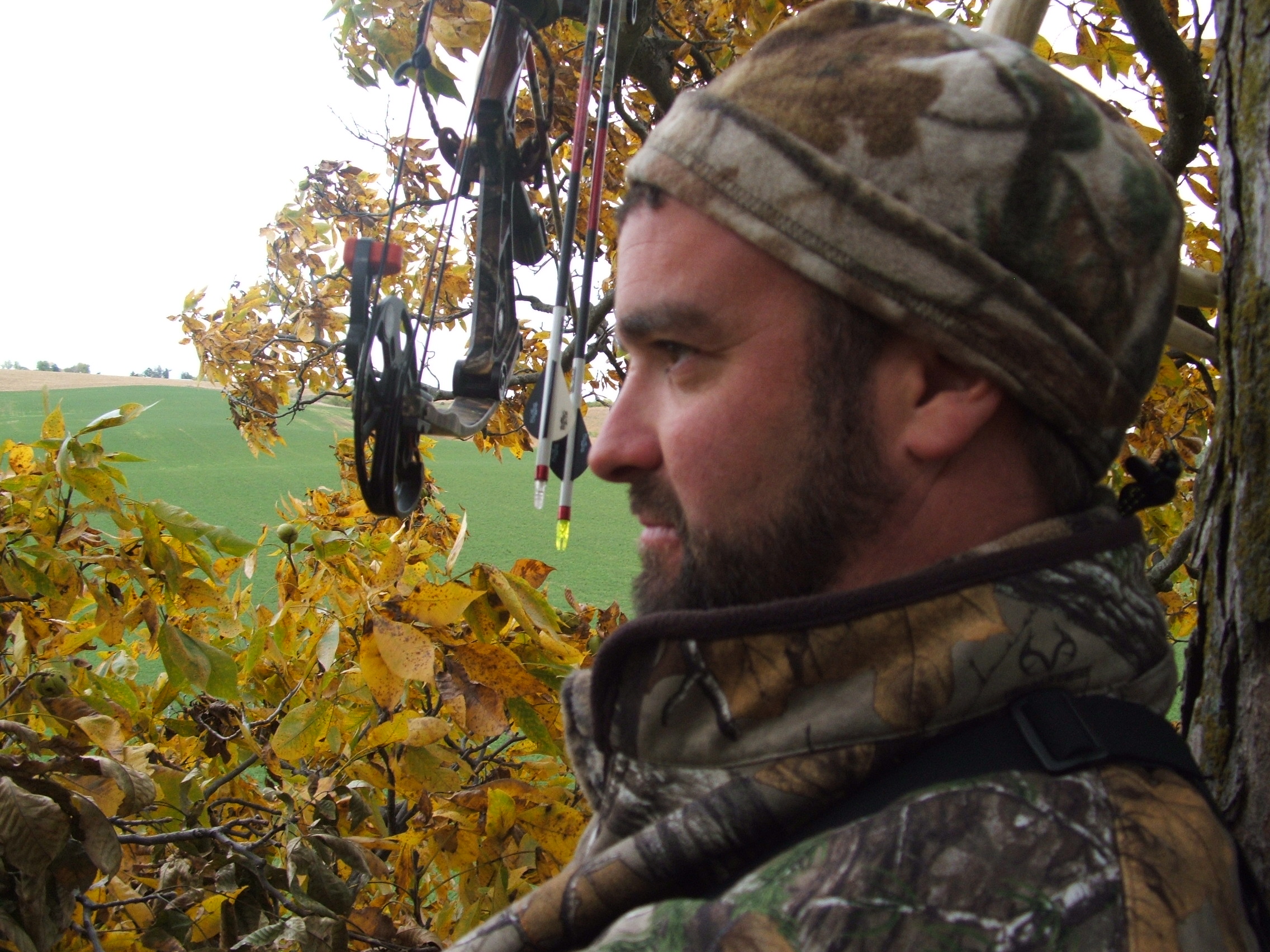
Here’s Ryan in one of the farms’ best spots overlooking an alfalfa field. We saw a number of deer with a couple decent bucks. The biggest being what we feel was a 3 year old ten point that was pretty far away. Beautiful night to be on stand.
The typical deer hunt for me is a 5 or 6 day hunt on a good piece of ground with a 130 to 140 class minimum. I would lean towards the “self guided” hunts that I could sit all day on. I liked having a farm to myself and a couple of friends for a week and see what I could accomplish. Finding Tom and his place far exceeded my previous expectations.
I got to know Tom, and his son Forest, throughout the summer with phone calls and the occasional meeting for a quick burger. I was anxious to see what he could tell me about the farm and what was going on with food plots and other farm work. I was emailing him constantly looking for updated trail cams of the farm, to say I was excited to have an Iowa tag was an understatement.
Tom has a passion for working hard to make sure his clients have a high success rate of killing deer. Tom, his son Forest, and wife Amy put in a lot of effort into making sure I was going to have a great hunt with them. I cannot even guess how many hours they put in cultivating the food plots, working on the cabin, and rearranging tree stands to get them in the best possible spots for me. I truly felt guilty knowing how many trips to the farm they took and the resources they used to make sure I was going to enjoy my stay at the cabin. Their hard work went way above and beyond what I was used to in the past and I still appreciate that right now.
Tom finally turned me loose when hunting season finally arrived. I tried to not over hunt the farm and only hunted when the conditions for deer movement were right. I updated Tom on how my daily hunts were going and would ask for his advice when I questioned my tree stand choice for the day. I would do that not only for me, but also because I knew Tom wanted me to have the best opportunity at a mature deer. I asked Tom to come down and hunt with me and he never hesitated. We sat 2 different weekends with his camera in hand and my bow in mine. He was after some footage for his web site and I was after having a higher opportunity at the chance to fill my tag. The plan almost came together for both of us. Tom had given me exactly what I was after and I didn’t close the deal. I had my buck of a lifetime at 7 yards slightly quartering towards me and I foolishly pulled the trigger of my release. I had hit the deer in the front shoulder with an expandable broad head. We spent 2 days tracking him through the woods and finally ended up jumping him up in some crp switch grass. He bounded off out of sight across a corn field. Later, Tom got some trail cam pictures of him and I was so thankful that we knew the outcome of this magnificent animal. (For a view of an edited version of Ryan’s buck encounter, click HERE)
I can honestly say this hunt at Full Potential Outdoors was outstanding. There are mature deer that live on Tom’s farm no question about it, I have seen them for myself bouncing around the farm chasing does and eating groceries on the food plots. Between the crp switch grass, food plots, hardwoods and the bedding areas, it makes for perfect deer habitat. The best part of the farm, I think, is the bedding area’s that went completely untouched by anyone. Having a piece of ground on your farm that never gets intruded by humans is outstanding. I will be saving up a couple more Iowa points and will back with Tom in a couple of years. Thank You Tom, Amy, and Forest for providing a great hunt for me, I truly appreciated it!
Ryan
Thank you Ryan for that endorsement…and I’m glad you had a good hunt! I look forward to the day we share a cold morning on stand again.
After every season, I always try to take a step back and give an honest review of the year just completed. Taking an honest assessment is hard. After hundreds of hours preparing, planning, and implementing it is not easy to admit mistakes or accept when things don’t go as planned. But, if you let your pride get in your way, you will never be able to move on and improve.
The first thing and rather big thing we did this past year was erect an electric fence around 2 of our food plots. Both plots were soybeans and the goal was to make them last longer specifically trying to guarantee standing soybeans for a late muzzleloader hunt. To that end, the electric fence was a major success.
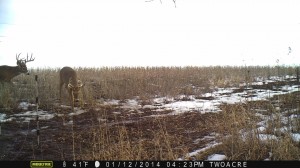
This 2 acre bean field was still drawing deer into mid to later January when the beans finally ran out. I removed the fencer and pulled the fence down in late fall releasing the plot planning a late muzzleloader hunt. About 10-30 deer fed on the beans almost every night once released
But we learned a lot about how to do it and had a couple things go wrong that needed to be fixed. First off, with the late summer drought, we found the fence wasn’t always shocking because the ground was so dry. What we did to address this was run a good ground rod into the ground at the opposite side of the field; and we ran another wire all the way around the plot isolated from the “hot” side of the fencer.
This extra wire was actually connected to the “negative” side of the fencer and the ground rod. This ensured any deer passing through would get zapped. We also found that the wire had worn through several of the plastic insulators at one of the corners. We think it wore through just because of the friction when pulling the wire through during the installation. This severally drained the fencer and gave a weak shock until we found the problem in mid-summer. In regards to return on investment, the electric fencing for last year was ok. It was a fair amount of work and expense to install it and keep it clean of weeds and because of the grounding issues we had and the worn insulators it only worked about half as good as we had planned the first year. No doubt, this next year it will work much better and I would recommend this idea to anyone trying to make food plots last a little longer!
We made another interior food plot this year calling it the broken toe…subsequently renaming it to the “Cage Fight” after Ryan Hyer sat it a couple times. I would have to admit that the “Cage Fight” did not show the activity and sign I would have predicted. Don’t get me wrong, deer were visiting and using the interior plot, but I had expected more. The one thing that I can think of that will make this spot get better and better over time is the slashing we cut adjacent to the plot. I think over the next year or two, as the slashing grows up more and gets thicker the “Cage Fight” will only get better.
I had expected the slashing to be the primary bedding area for the deer, but I think other areas still saw good bedding activity. I’ve seen this before…that is as slashings adjacent to my interior food plots thicken, they both see exponential improvements in deer activity. I expect that next year the “Cage Fight” will get better. Remember that with habitat improvement projects like interior plots and slashings the results sometimes take a little longer to see but are almost permanent in nature and outperform other methods of increasing deer activity on your ground and your ability to hunt it.
“The Boot” interior food plot stole the show in my opinion this past year. It is an interior plot that leads out to an exterior plot of soybeans. I had more day time photos of mature bucks on this plot than almost the rest of the cameras combined (not quite, but almost!!!). Interior food plots that lead out to an exterior preferred food source like soybeans have never failed me.
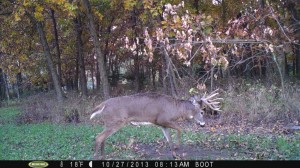
One of hundreds of picks of daytime activity on “The Boot” interior plot. In this pic, a nice buck is pawing a mock scrape I made in early fall. The plot and scrape were pounded all fall.
I took one muzzleloader hunter this year that Mother Nature got the best of. After only two days of hunting in frigid below zero temps (as low as -25) and 30+mph winds he threw in the towel. Although I understand completely, it’s too bad because deer were feeding heavily on my standing beans and I know a couple good bucks were feeding in them. This did however teach me another lesson…I had used a couple pop up blinds that were staked to the ground with every stake they come with and they still tore lose making them flappy for the hunter. I’ve used these type blinds for years and never had that problem…well, lesson learned. If you plan on leaving out blinds into January you had better make them either permanent or stake them down at all four corners with fence posts or something that can handle 30+mph winds for days on end!!!
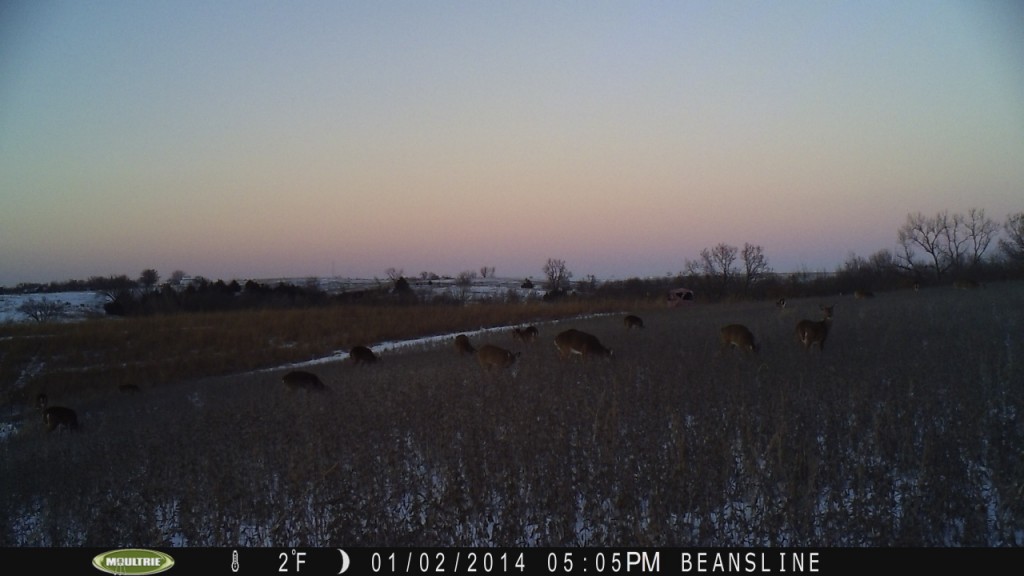
This shows a couple things. Into January and the beans are still getting hit, and the plot is still not consumed because of the fencing. See the blind in the background…in a day or two the winds almost ripped this blind to pieces. In the future, I will be using more permanent blinds for late season hunting.
So, in conclusion, what I took from 2013 is that interior plots are still great places to hunt deer, soybeans are still my number one food plot, electric fencing food plots for later release works when paying attention to details…and late season blinds need to be robust enough to handle continued 30+ mph winds. Can’t wait for 2014!

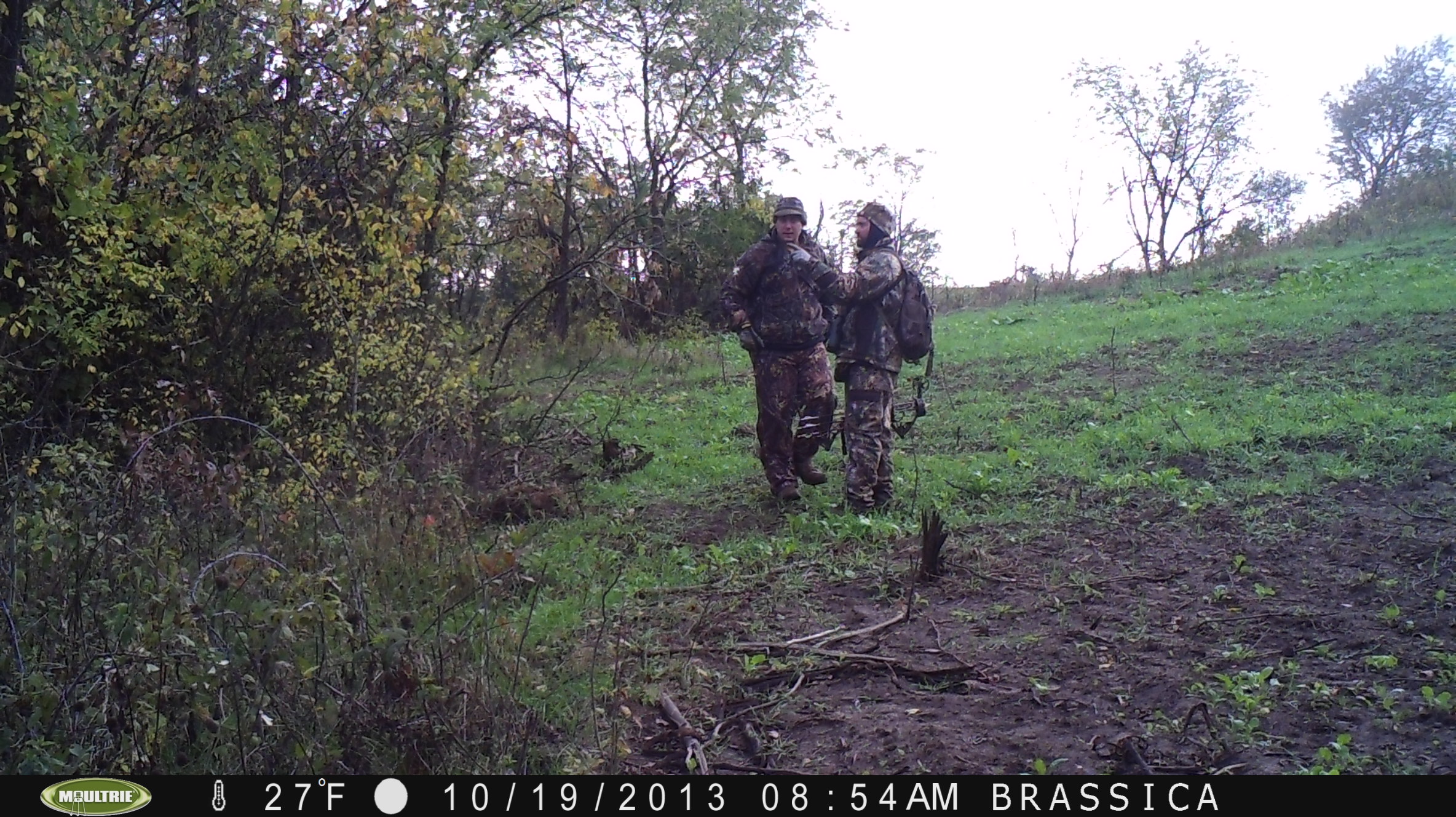

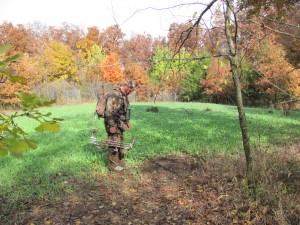
Another great artical Peppy. I really enjoy reading everything you write and try to use it on my property and while hunting. Unfortunate luck for Ryan but I think a few of us have been in that same situation sometime in our hunting adventures. Glad the buck showed himself again they are amazing critters to take a shot and survive. Keep the great info coming Peppy.
The buck made it just fine. Ryan felt awful once we knew it was not good. He is a good hunter and I’m sure he will second guess that shot for a long time.
Peppy If you dont mind me asking what did you have planted in “The Boot”?
Matt, the “Boot” last year was mostly winter rye with some cold tolerant oats and a few essex rape seeds thrown in. All seeds bought bulk from farm or ag suppliers. The rye I bought directly off the field from a local farmer (shop craigslist in late summer). Planting green is a must for interior plots and I like annuals planted around Sept 1st or so. Location of these plots is more important than what kind of actual seed (except that they need to be green). Interior plots planted in the timber maybe 50 to 75 yards with a lane or trail leading out to a preferred exterior plot like beans is great….which is what “The Boot” is.
Thanks for all the great info Peppy. Glad to hear the buck made it.